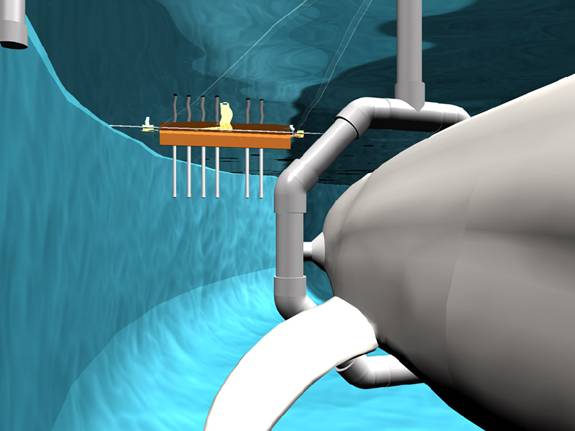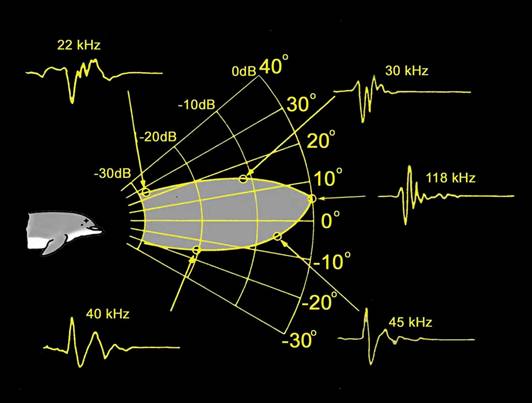
Lay Language Paper Index | Press Room ]
Brian K. Branstetter, branstet@hawaii.edu
Marine Mammal Research Program,
Hawaii Institute of Marine Biology
Univ. of Hawaii, Honolulu, HI 96822
Eduardo Mercado III.
University of Buffalo, State University of New York.
Popular Version of Paper 2pAB3,
Presented 1:45 p.m., Wednesday afternoon, November 28, 2007,
154th ASA Meeting, New Orleans, LA
Dolphins echolocate by producing a train of high-frequency, short-duration clicks, and then listening to returning echoes (Au, 1993a). A primary function of the dolphin echolocation system is to facilitate hunting of fish and squid in dark, murky and often turbulent conditions where vision can be limited or useless. This requires the dolphin to echoically detect, identify, locate, pursue, and capture prey that are often swiftly moving. Their ability to echoically localize multiple moving prey targets in three dimensions suggests that dolphins have a well-developed spatial representation of their acoustic environment. Laboratory evidence suggests likewise. A dolphin named Elele demonstrated a keen ability to match an object initially inspected through echolocation, to an identical object seen later though vision, and vice versa (Herman et al., 1998; Pack et al., 2002). The matching object was among two other non-matching alternative objects, as well as a “none of the above” paddle that she used when none of the objects matched. Her performance in this task was excellent. Furthermore, she could perform this feat with objects she had never before observed, and on the first try. These results suggest that mental representations of both vision and echolocation share enough of the same spatial properties that matches can be made across the two modalities. In other words, the dolphin can likely perceive the shape of objects through both echolocation and vision.
Although echolocation may not yield as much spatial detail as vision, (just like feeling an object with your hand might not render the same details as seeing an object) evidence suggests dolphins can perceive spatial information (though passive listening or while echolocating) with about 1 degree of resolution in both the horizontal and vertical planes (Renaud and Popper, 1975; Branstetter et al., 2007). Although most animals can localize well in the horizontal plane, most are not as proficient at localizing sound sources in the vertical plane. Dolphins are one of the few animals that apparently do not share this limitation.
 |
| Fig 1. 3-D rendering of a dolphin with eyecups echoically localizing an array of PVC rods during a discrimination task (Branstetter et al., 2003; Branstetter et al., 2007). The dolphin was required to pick which side (left or right) the four rods were located (left on this trial). When the dolphin was correct the space between the two and four rod arrays was reduced to make the task harder. The dolphin could resolve the spatial locations of the rods with about 1 degree of accuracy. |
How are dolphins able to echoically localize sound so well they can catch swiftly moving prey and perceive the shape of objects? It appears the dolphin’s sonar system may have evolved largely for high-resolution localization or “acoustic imaging.” The sonar signals dolphins use are optimized for locating the position of small prey. The high-frequency clicks that dolphins emit have very small wavelengths, ideal for producing echoes off of small objects (Au, 1980; Au, 1993b). Longer wavelengths from low-frequency sounds will tend to wrap around small objects rather than reflect off of them. The clicks are also very short in duration (as short as 40 microseconds) which allows the dolphin to localize multiple targets that are clustered together at varying distances. Most of the sound energy in their clicks is focused forward in a tight beam (Au et al., 1986), and recent evidence suggests dolphins can reshape and steer the direction of their beam pattern when searching for targets (P. W. B. Moore, pers. comm.). This aids in locating the general direction of targets and allows them to detect targets at greater ranges (Au, 1993a).
 |
| Fig 2. Echolocation beam patter of the bottlenose dolphin (Au, 1993b). Most of the acoustic energy of sonar signals are directed forward in a tight beam. |
Their enhanced ability to localize in the vertical plane may be related to asymmetrical cranial structures that are a common feature of many toothed whales (Branstetter and Mercado III, 2006). In the barn owl (Tyto Alba), when sound enters the ears, the asymmetric ear flaps produce a unique filtering pattern for each sound source location (Knudsen, 1982). The owl can use the unique sound pattern to identify the precise location of sound sources. The dolphin’s streamlined head no longer has external ears (i.e., pinna), but instead hears sonar sounds through complex fat channels in their lower jaw that may function as a pinna analogue (Brill, 1988; Ketten, 1992; Møhl et al., 1999). Together with cranial asymmetrical structures (i.e., the skull) dolphins are hypothesized to localize sounds employing position dependant filtering much in the same way owls do. Furthermore, the high frequency, broadband (i.e., energy across a broad range of frequencies) nature of dolphin clicks is precisely the kind of sound that works best for position dependant filtering.